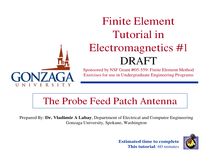Finite Element Tutorial in Electromagnetics #1
55
pages
English
Documents
Le téléchargement nécessite un accès à la bibliothèque YouScribe Tout savoir sur nos offres
55
pages
English
Documents
Le téléchargement nécessite un accès à la bibliothèque YouScribe Tout savoir sur nos offres
Publié par
Langue
English
Finite Element
Tutorial in
Electromagnetics #1
DRAFT
Sponsored by NSF Grant #05-559: Finite Element Method
Exercises for use in Undergraduate Engineering Programs
The Probe Feed Patch Antenna
Prepared By: Dr. Vladimir A Labay, Department of Electrical and Computer Engineering
Gonzaga University, Spokane, Washington
Estimated time to complete
This tutorial: 60 minutesOutline of Tutorial
1. Introduction
2. Overview of computational electromagnetics (CEM)
– Maxwell’s Equations and their numerical approximation
–F ul-wave CEM techniques
• The method of moments (MoM)
• The finite difference time domain (FDTD) Method
• The finite element method (FEM)
3. The CEM modeling process
–Overiew
– Methods of CEM
– Problems and Limitations
4. Finite Element Method (FEM)
– Introduction and Overview
– Strengths and Weaknesses
–Weakness
2(con’t)
Outline of Tutorial
5. Ansoft’s High Frequency Structure Simulator (HFSS)
–Introduction
– Using HFSS to create and improve designs
6. Problem Definition: The Probe Feed Patch Antenna
– Basic Characteristics of Microstrip/Patch Antennas
– Design Equations based on the Transmission Line Model
–S ample Design
7. Step-by-Step Solution
–L aunching Ansoft HFS
– Set up the Design
– Creating a Model
– Set up and Generate Solutions
– Analyze and display results
8. Further Reading and References
3Tutorial Objectives
• Understand the basis of FE theory for three-dimensional electromagnetic analysis.
(PEO #1)
• Understand the fundamental basis of the radiation field pattern in a patch
antenna beam through the use of Ansoft’s High Frequency Structure Simulator
(HFSS)™ three-dimensional finite element software. (PEO #2)
• Be able to construct a correct solid model using the build in 3-D solid modeler and
perform a correct three-dimensional finite element analysis using HFSS solution
engine. (PEO #3)
• Be able to interpret and evaluate finite element solution quality including verifying
convergence criterion and field plots. (PEO #4)
4Overview of Computational
Electromagnetics (CEM)
•Electromagnetics
– The study of electrical and magnetic fields and their interaction
– Governed by Maxwell’s Equations (Faraday’s Law, Ampère’s Circuital Law, and Gauss’ Laws)
• Maxwell’s Equations relate the following Vector and Scalar Fields
E: the Electric Field Intensity Vector (V/M)
H: the Magnetic Field Intensity Vector (A/m)
2
D: the Displacement Flux Density Vector (C/m )
B: the Magnetic Flux Density Vector (T)
2
J: the Current Density Vector (A/m )
3
ρ: the Volume Charge Density (C/m )
μ: is the Permeability of the medium (H/m)
ε: the Permittivity of the medium (F/m)
5Maxwell’s Equations
Faraday’s Law: Ampère’s Circuital Law:
∂
∂
∇ × E = − B
∇ × H = J+ D
∂t
∂t
Constitutive Equations:
Gauss’ Laws:
B = μ H D = ε E
∇ ⋅ B =0 ∇ ⋅ D = ρ
• Actual solution complex and for realistic problems require approximations
• Numerical approximations of Maxwell’s equations is known as computational
electromagnetics (CEM)
6Applications of CEM
• Over the past five decades CEM has been successfully applied to several engineering
areas, including:
– Antennas
– Biological electromagnetic (EM) effects
– Medical diagnosis and treatment
– Electronic packaging and high speed circuits
– Superconductivity
– Microwave devices and circuits
– Law enforcement
–E nvironmental isues
–Avionics
– Communications
– Energy generation and conservation
– Surveillance and intelligence gathering
–H omeland Security
– Signal Integrity
7Full-wave CEM techniques
• Approximations of Maxwell’s equations may be classified into several categories, e.g.,
low-frequency, quasi-static, full-wave, lumped element equivalent, etc.
• This tutorial deals with the finite element method a full-wave technique. Full-wave
techniques have the potential to be the most accurate of all numerical
approximations because they incorporate all higher order interactions and do not
make any initial physical approximations
•E xamples include:
– Finite difference time domain (FDTD) Method
– Method of Moments (MoM) Method
– Finite Element (FEM) Method
– Transmission Line Matrix (TLM) Method
– The Method of Lines (MoL)
– The Generalized Multipole Technique (GMT)
The FDTD, MoM and FEM are the most popular today!
8(con’t)
Full-wave CEM techniques
• Central to all methods is the idea of discretizing some unknown electromagnetic
property, for example:
– MoM: the Surface Current
– FE: the Electric Field
– FDTD: the Electric and Magnetic Field
• Discretization is also known as meshing that subdivides the geometry in a large
number of elements
– Two dimensional elements: triangles
– Three dimensional elements: tetrahedral
• Within each element, a simple functional dependence (basis functions) is assumed
for the spatial variation of the unknown
• The amplitude and phase of the unknown quantity is determined by the application
of the particular CEM
9Limitations of Full-wave CEM
techniques
• CEM is a modeling process and therefore a study in acceptable approximation
• In other words, CEM replaces a real field problem with an approximate one which
causes limitations and problems that one must keep in mind
• Limitations of the mathematical model and Simplifications in the formulation
– Assumptions are generally made, e.g., assuming an infinite ground plane in an antenna
structure. Are the assumption valid?
– Have you made simplifications on the design that are not valid? For example, simplifying a
thin wire by a current filament.
• Tolerances and Manufacturing deviations
– Tolerances are a part of all manufactured devices. How do small changes in dimensions or
material properties affect the performance?
– Do other manufacturing considerations, other that tolerances, affect the performance?
• Finite Discretization
– Is the mesh fine enough to properly so that the basis functions can adequately represent the
fields?
• Numerical approximations and Finite machine precision
– Does double precision provide enough accuracy for your problem, especially if it is ill
conditioned?
10
